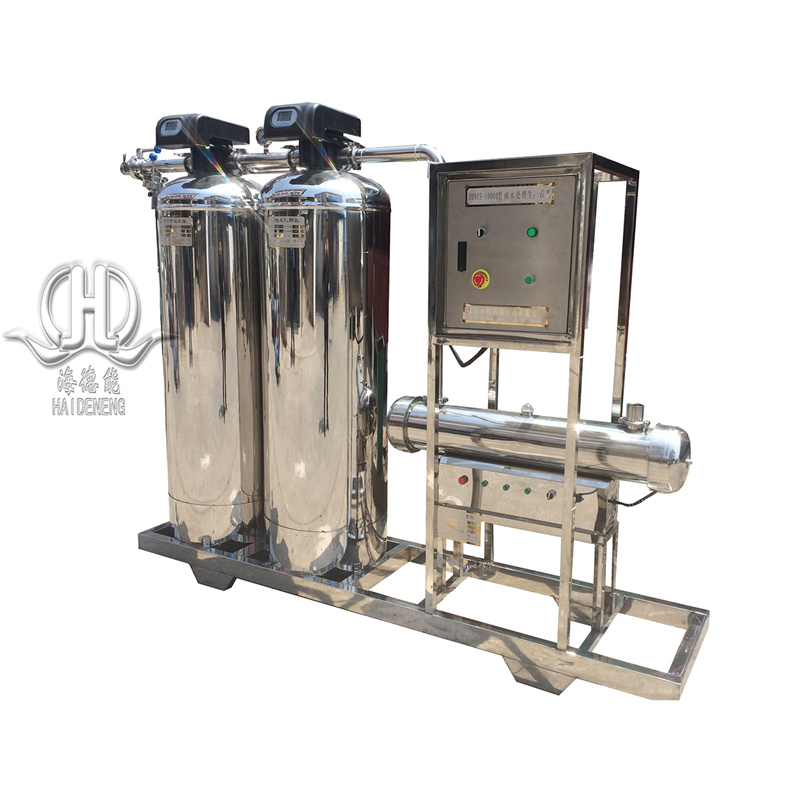Fully Automatic Reverse Osmosis Equipment with Water tank for Reducing Salinity and Softening Water Quality
Product description
Key Components and Functions
-
Pre-Filtration System
- Sediment Filter: Removes large particles (e.g., sand, rust, silt) to protect downstream components.
- Activated Carbon Filter: Reduces organic compounds, chlorine, odors, and 色度 (color) to improve water taste and protect the RO membrane.
- Softening Unit (Optional): Uses ion exchange resin to remove calcium and magnesium ions, reducing water hardness and preventing membrane scaling.
-
Reverse Osmosis Membrane Module
- RO Membrane: A semipermeable membrane with pore sizes as small as 0.0001 microns, effectively removing dissolved salts (e.g., NaCl), heavy metals (e.g., lead, arsenic), bacteria, viruses, and other contaminants.
- High-Pressure Pump: Generates the pressure required to force water through the RO membrane against the osmotic pressure.
-
Automatic Control System
- PLC/Touchscreen Controller: Manages the entire process, including startup/shutdown, flushing cycles, and fault detection.
- Sensors: Monitor parameters like inlet/outlet pressure, flow rate, conductivity, and pH to ensure optimal performance.
- Automatic Flushing: Periodically flushes the RO membrane to prevent pollutant accumulation and extend membrane life.
-
Storage Water Tank
- Food-Grade Polyethylene Tank: Stores treated water for continuous use, with a capacity ranging from 100 liters to several cubic meters (customizable based on demand).
- Level Sensors: Automatically control water inflow/outflow to maintain tank levels and prevent overflow or dry running.
-
Post-Treatment (Optional)
- UV Sterilizer: Eliminates residual bacteria or viruses in the treated water.
- Mineral Addition Unit: Adds beneficial minerals (e.g., calcium, magnesium) if desired for drinking water applications.
Working Principle
- Pre-Treatment: Water passes through sediment and carbon filters to remove physical and organic contaminants. If included, the softening unit reduces hardness by exchanging calcium/magnesium ions with sodium ions.
- Reverse Osmosis: Pressurized water flows through the RO membrane, where dissolved salts and impurities are retained as concentrate (brine), while purified water (permeate) is collected.
- Concentrate Disposal: The reject water (concentrate) is discharged or recycled (e.g., for non-potable uses), with a recovery rate typically between 70–90% (depending on water source and system design).
- Storage and Distribution: Treated water is stored in the tank and supplied on demand, with the automatic system ensuring a steady flow and pressure.
Technical Specifications (Typical)
| Parameter | Range/Value |
|---|---|
| Inlet Water Salinity | ≤2000 ppm (adaptable to seawater ≤35,000 ppm with upgrades) |
| Output Salinity | ≤50 ppm (potable water standard) |
| Flow Rate | 500–10,000 L/h (customizable) |
| Operating Pressure | 10–15 bar (for brackish water); 60–80 bar (for seawater) |
| Power Supply | 220V/380V AC, 50/60Hz |
| System Dimensions | Varies by capacity (e.g., compact skid-mounted for small systems) |
| Material | Stainless steel/FRP for corrosion resistance |
Applications
- Residential/Commercial: Producing drinking water, reducing scaling in plumbing systems, and improving appliance lifespan (e.g., water heaters, boilers).
- Industrial: Water for manufacturing processes (e.g., pharmaceuticals, electronics, cosmetics), cooling towers, and boiler feedwater.
- Marine/RV: Seawater desalination for ships, yachts, or recreational vehicles.
- Agriculture: Irrigation water for crops sensitive to high salinity or hardness.
Advantages
- Fully Automatic Operation: Reduces manual labor and human error, with real-time monitoring and self-adjustment.
- High Efficiency: Low energy consumption (especially with energy recovery devices for seawater systems) and high water recovery rates.
- Durability: Corrosion-resistant materials and long-lasting RO membranes (replaceable every 3–5 years with proper maintenance).
- Flexibility: Customizable for different water sources (brackish water, well water, seawater) and output requirements.
- Cost-Effective: Lower long-term costs compared to bottled water or chemical softening methods.
Maintenance and Care
- Regular Filter Replacements: Sediment and carbon filters should be replaced every 3–6 months (depending on water quality).
- Membrane Cleaning: Chemical cleaning as needed to remove organic/inorganic fouling (e.g., every 6–12 months).
- System Checks: Periodic inspection of pumps, valves, and sensors to ensure leak-free operation and optimal performance.
Compliance and Standards
-
Meets international standards for drinking water (e.g., WHO, NSF/ANSI 58 for RO systems).
-
CE certification available for European markets; other regional certifications (e.g., UL, CSA) can be obtained upon request.
For specific customization or pricing, please provide details about your water source (e.g., salinity, hardness), required flow rate, and application scenario.
Write your message here and send it to us












